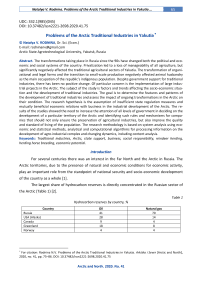Problems of the Arctic traditional industries in Yakutia
Автор: Rodnina Natalya V.
Журнал: Arctic and North @arctic-and-north
Рубрика: Social and economic development
Статья в выпуске: 41, 2020 года.
Бесплатный доступ
The transformations taking place in Russia since the 90s have changed both the political and economic and social systems of the country. Privatization led to a loss of manageability of all agriculture, but significantly negatively affected the traditional agricultural sectors of Yakutia. The transformation of organizational and legal forms and the transition to small-scale production negatively affected animal husbandry as the main occupation of the republic's indigenous population. Despite government support for traditional industries, there has been no positive change. Of particular concern is the implementation of large industrial projects in the Arctic. The subject of the study is factors and trends affecting the socio-economic situation and the development of traditional industries. The goal is to determine the features and patterns of the development of traditional industries and assess the impact of ongoing transformations in the Arctic on their condition. The research hypothesis is the assumption of insufficient state regulation measures and mutually beneficial economic relations with business in the industrial development of the Arctic. The results of the studies showed the need to increase the attention of all levels of government in deciding on the development of a particular territory of the Arctic and identifying such rules and mechanisms for companies that should not only ensure the preservation of agricultural industries, but also improve the quality and standard of living of the population. The research methodology is based on system analysis using economic and statistical methods, analytical and computational algorithms for processing information on the development of agro-industrial complex and changing dynamics, including content analysis.
Traditional industries, arctic, state support, business, social responsibility, reindeer herding, herding horse breeding, economic potential
Короткий адрес: https://sciup.org/148318362
IDR: 148318362 | УДК: 332.1(985)(045) | DOI: 10.37482/issn2221-2698.2020.41.75
Текст научной статьи Problems of the Arctic traditional industries in Yakutia
For several centuries there was an interest in the Far North and the Arctic in Russia. The Arctic territories, due to the presence of natural and economic conditions for economic activity, play an important role from the standpoint of national security and socio-economic development of the country as a whole [1].
The largest share of hydrocarbon reserves is directly concentrated in the Russian sector of the Arctic (Table 1) [2].
Hydrocarbon reserves by country, %
Table 1
|
Country |
Oil |
Natural gas |
|
Russia |
41 |
70 |
|
USA (Alaska) |
28 |
14 |
|
Canada |
9 |
4 |
|
Greenland |
18 |
8 |
|
Norway |
4 |
4 |
In this regard, the further spatial development of the new Russia is inevitably linked to its Arctic zone. The importance of the Arctic for the economy and the future of Russia is enormous. Almost all types of natural resources are located in the Arctic, and their extraction can now proceed at an accelerated pace.
Recognition of the Arctic not just as a raw material appendage, but as a zone of strategic interests, determines the growing role of socio-economic development of the Arctic zone of the Russian Federation (AZRF).
At the same time, the process of resource development should take into account not only the interests of companies carrying out production activities in the area concerned, but also the interests of the region in which the deposits are being exploited.
This also applies to the Republic of Sakha (Yakutia). The Yakutia Arctic is a territory of traditional nature management and agricultural production, represented by traditional industries such as reindeer herding, horse breeding, hunting and others. The socio-economic development of the Yakutia Arctic is impossible without the preservation of these important industries, both from the standpoint of protecting the interests of the indigenous small-numbered peoples of the North, and from the standpoint of ensuring food self-sufficiency in the region itself. An integrated and systematic approach is required to determine measures of state regulation of the further development of the Arctic zone of Yakutia.
Importance of the Arctic Yakutia for Russia
There are more than 100 types of minerals on the territory of the Arctic zone of the Republic of Sakha (Yakutia): rare earth metals, diamonds, oil, gas, tungsten, copper, antimony, gold, silver and other natural resources, including diamond placers on the Anabar, Olenek, Molodo, Motorchuna, rivers, Tomtor rare earth metals deposit, Deputatskoe tin deposit, Kjuchus gold deposit and others [3].
The development project of the North Yakutsk support zone provides investments in the amount of about 360 billion rubles for the period from 2017 to 2030. The development of the extractive industry will contribute to the implementation of large infrastructure projects and an increase in cargo traffic up to 0.7 million tons [4].
Arctic zone of the Sakha Republic (Yakutia) is one of the priority geostrategic territories of Russia, which is located in the Eastern Arctic. The area of the territory of Arctic Yakutia is 1 608.8 thousand sq. km., or more than half of the entire territory of the republic (3 083.5 thousand sq. km). Its natural boundaries in the north are form the Laptev and East Siberian seas. The total length of the sea coastline exceeds 4.5 thousand km. It is bordered to the west by the Krasnoyarsk Territory, to the east — by the Chukotka Autonomous Okrug, to the south — by 6 municipal regions of the republic: Mirninskiy, Nyurbinskiy, Vilyuyskiy, Kobyayskiy, Tomponskiy i Oymyakonskiy regions. The Arctic zone of the Sakha Republic (Yakutia) includes — 13 regions, including 4 national ones; — 84 mu- nicipalities of the settlement level, including 29 national ones; — 119 settlements: 2 cities, 10 urban-type settlements and 107 rural settlements, 22 of which have no permanent population.
According to preliminary estimates, the population of 13 Arctic regions of the republic as of January 1, 2019 is about 68 thousand people with a specific weight in the total population of the republic of only 7.0%. At the same time, in terms of the occupied area, it is 52.2%. The population density is 0.04 inhabitants per sq. km. The most numerous population lives in the Verkhoyanskiy district — 11.1 thousand people (16.5% of the population of AZ), and the smallest number is in the Al-laykhovskiy district — 2.7 thousand people (4.0%).
More than 60% of the population of the Arctic zone of the republic is rural residents. The share of agriculture in the gross municipal product of the AZ of SR (Ya) is about 4% (SR (Ya) — 1.8%). Among the districts, the Verkhoyanskiy District (26.8% of the total gross agricultural output), Ana-barskiy (17.6%), Srednekolymskiy (12.3%) and Eveno-Bytantayskiy (9.3%) districts make the largest contribution to the industry, which mainly engaged in breeding cattle and meat herd horses.
At the same time, the Arctic zone is characterized by a difficult social situation: according to the results of 2018, the share of the population with incomes below the subsistence level was 19.6%, the level of registered unemployment was 4.9%, which is 2.9 times higher than the national average (1,7%), the mortality rate was higher than the national average (9.9 ‰ versus 7.8 ‰), the migration loss rate in 2018 was (–) 11.5 per 1 000 people, which is more than 3,5 times higher than the national average (– 3.0 ‰).
At a meeting in St. Petersburg, the President of Russia noted that now, “... when the Arctic zone of Russia is experiencing a new stage of industrial, socio-economic, infrastructural revival, it is especially important to concentrate as much as possible on the topic of nature conservation. I repeat, when involving this region in the economic turnover, we must adhere to a carefully verified, balanced approach. It is based, firstly, on accurate knowledge of the resource and natural potential of the Arctic and an objective assessment of the feasibility of certain actions, the development of our own scientific and technological capabilities for the development of the North; secondly, clear, obligatory adherence to the strictest environmental standards, the unconditional priority of environmental protection measures; thirdly, the utmost transparency of economic activity in the Arctic, and this also presupposes a constant dialogue with civil society institutions, with environmental and ecological organizations —naturally, first of all, with those who pursue genuinely noble goals, and do not speculate on environmental problems, does not turn them into a subject of bargaining, own PR or business” 1.
Thus, the President of the country has given clear guidelines for preserving the nature of the Arctic as a national interest, which, of course, will make it possible to respect the interests of the northern peoples and preserve their vital activity.
“The country has managed to set a course for the integrated development of the northern territories <...> Our goal is to preserve resources and people in the Arctic, to build visible, long-term life prospects for people”, — Rogozin noted2.
The main goal of the state is to improve the quality and standard of human life. The development of agro-industrial production in the Arctic is the most important economic and social task.
The state of traditional industries in the Arctic zone of Yakutia
The economy of the rural areas of the Yakutia Arctic is based on traditional forms of nature management. The Republic of Sakha (Yakutia) belongs to one of the main reindeer husbandry regions of Russia, in which reindeer husbandry is a branch of traditional farming that determines the way of life of the indigenous peoples of the North.
Northern domestic reindeer husbandry is developed in Ustyanskiy, Nizhnekolymskiy, Eveno-Bytantayskiy, Anabarskiy, Bulunskiy, Momskiy districts. The main branches of animal husbandry (mainly Verkhoyansk, Srednekolymskiy, Eveno-Bytantayskiy, Momskiy, Abyyskiy districts) also include herd horse breeding [5].
Sustainable development of the regional agrarian economy depends on the influence of internal and external factors. Organizational and economic changes in the 1990s affected all branches of agriculture, but especially the traditional branches of the North.
In the reindeer husbandry industry, the main problems that hinder its transition to a qualitatively new level of development remain:
-
1. Land:
-
• lack of land surveying and the need for costly monitoring of the state of reindeer pastures;
-
• unresolved issues of land use;
-
2. Economic:
-
• lack of a developed system of indicators for assessing the economy of reindeer husbandry;
-
• lack of organizational and economic measures for conducting the industry;
-
• weak material and technical and personnel support;
-
• low level of human resources [6].
Herd horse breeding is also the industry that best suits the local climatic conditions, labor skills and traditions of the indigenous population of the republic, which makes it possible to produce the largest amount of products with the least labor and cost.
HORSES
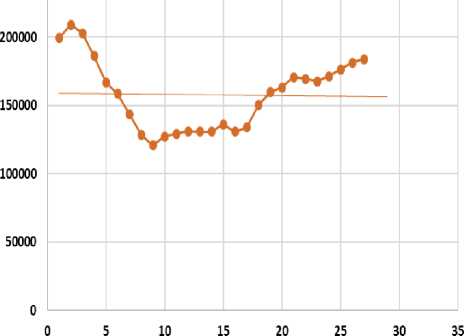
Fig. 1. Dynamics of the population of deer and horses in the Republic of Sakha (Yakutia) for the period from 1990 to 2017
A retrospective analysis indicates the presence of cyclical features in the development of these industries, equal to approximately 8-12–year periods (Fig. 1).
Taking these features into account and taking appropriate measures, certain negative trends in the development of reindeer and herd horse breeding could have been avoided. As a result of the annual reduction in the number of domesticated reindeer and horses as of January 1, 2018, their numbers amounted to 154.6 and 184.2 thousand respectively (Fig. 2). For reference: the number of reindeer in 1985 was 369.5 thousand heads in the republic as a whole, and herd horses in 1990 — 199.5 thousand. With these indicators, Yakutia ranks second in Russia in terms of the number of herd horses and fifth in terms of the number of domesticated reindeer.
DEER
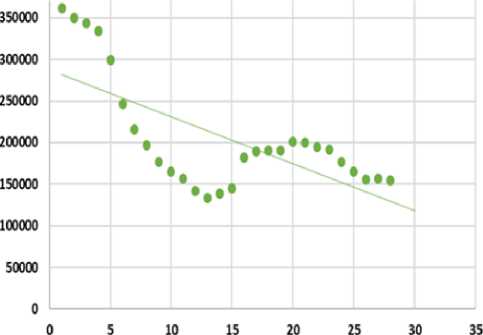
Number of herd horsis in the Russian Federation as of January 1,2018, thoysand golos
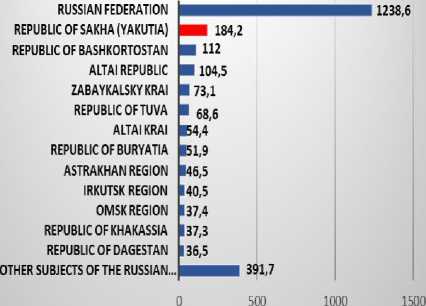
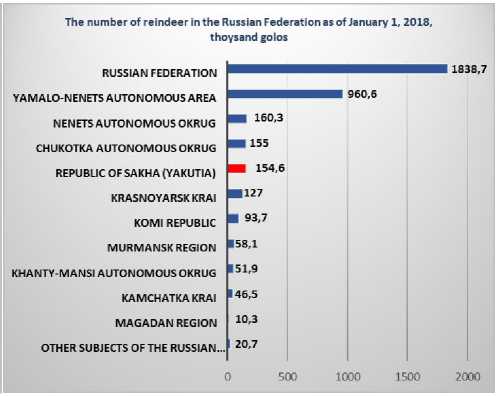
Fig. 2. Share of the Sakha Republic (Yakutia) in the total number of deer and horses in the Russian Federation as of January 1, 2018.
During the Soviet period, there was quite intensive government support that created a platform for the development of the Arctic. Support measures were envisaged in the form of northern and regional coefficients to wages, guaranteed benefits and compensation for expenses when leaving for treatment, good food and material security.
State support is also provided today. Thus, the basis of Russia's Arctic policy is determined by the model of sustainable development of the Arctic territories and an integrated approach to solving the problems of socio-economic development of the indigenous peoples of the North, the main components of which are: social, i.e. creation of conditions for self-development and selfsufficiency of indigenous small-numbered peoples of the North, economic (sustainable exploitation of resources, development of regional infrastructure and ensuring the participation of indigenous communities in the implementation of large-scale projects) and ecological, ensuring environmental protection, limiting the negative impact of industrial activities on the territory of nature use of peoples of the North, preservation of biodiversity in the region [7].
The Republic of Sakha (Yakutia) is actively involved in the implementation of the agrarian policy of the Russian Federation and the implementation of the main goals and objectives of federal state programs. This is facilitated by the republican law on the development of agriculture, adopted in 2016. In addition, the Head of the Sakha Republic (Yakutia) elected in 2018, approved the priority goal of agricultural development as one of 5 strategic decrees — an increase in the level of provision of the population with high-quality food products of local production.
Meanwhile, despite the measures of state support provided in recent years, agriculture in the Far North and the Arctic is experiencing difficulties.
The low results of the development of industries indicate the incompleteness of the levers used by the state. Despite the program-targeted method of agricultural management, which is characterized by a strict orientation of the program to achieve the planned result, the allocation of the necessary financial, material and other resources for the program is not achieved [8].
The quality indicators in reindeer husbandry and horse herding are decreasing. From year to year, the yield of offspring decreases and the mortality rate increases (table 2).
Table 2
Breeding and mortality of deer and horses in agricultural enterprises of the Sakha Republic (Yakutia) 3
|
2005 |
2010 |
2015 |
2016 |
2017 |
2018 |
|
|
Breeding rate per 100 uterus |
||||||
|
foals |
39 |
56 |
61 |
64 |
61 |
40 |
|
tuguts |
57 |
54 |
46 |
49 |
46 |
44 |
|
Livestock mortality, percent of herd turnover |
||||||
|
horses |
4.9 |
3.1 |
2.3 |
2.1 |
2.5 |
3.6 |
|
deer |
12.6 |
15.6 |
19 |
16 |
17 |
22 |
-
3 Territorial body of the Federal State Statistics Service for the Republic of Sakha (Yakutia) (SAKHA (YAKUTIA) STAT). Statistical Collection No. 4/441. Agriculture in the Republic of Sakha (Yakutia) for 2005, 2010, 2015-2018. P. 63.
One of the problems of the Arctic territories is currently considered as the disturbance and degradation of pastures, the destruction of lichens and shrubs. Serious problems of reindeer pastures are applied by all-terrain vehicles and tractors, and other heavy equipment, which, as a rule, do not move along roads, but over vegetation [9].
Problems of low reproduction rates caused by the insignificant degree of breeding coverage and the difficult financial condition of farms, such as a weak fodder base, are added as a result of violations of the Arctic lands use.
Traditional industries practically do not develop. The investment potential during the study period did not undergo any positive and cardinal changes; the majority of agricultural producers have no investment activity at all. This primarily applies to reindeer herding and herd horse breeding. As it can be seen from the table 3, there were no investments and, therefore, no input of production assets in these industries.
Table 3
Implementation of production branches of agriculture in the Sakha Republic (Yakutia) 4
|
2005 |
2010 |
2015 |
2016 |
2017 |
2018 |
|
|
Implemented |
||||||
|
Livestock premises, thousand places: For cattle For pigs |
1.2 1.2 |
-0.05 |
0.7 - |
2.4 0.3 |
3.0 0.2 |
0.6 - |
|
Whole milk production capacity, tons per shift |
10 |
- |
- |
- |
- |
5.0 |
|
Bakery production capacity, tons per day |
- |
- |
- |
- |
- |
5.0 |
|
Storages for potatoes, vegetables, thousand tons |
0.4 |
- |
- |
- |
- |
- |
|
Power transmission lines for the electrification of agriculture |
28.9 |
3.13 |
62.4 |
11.4 |
7.1 |
9.4 |
As for the Arctic zone of the Sakha Republic (Yakutia), as of January 1, 2019, this territory contains 106.3 thousand heads of reindeer, or 72.5% of the total livestock. The main share of the reindeer herd is kept in the farms of Ustyanskiy (22.8%), Anabarskiy (16.6%), Bulunskiy (13.3%), Eveno-Bytantayskiy (12.4%), Nizhnekolymskiy (12.3%), Momskiy (10.3%) districts. Despite government support, the number of reindeer is decreasing every year, and in Abyyskiy and Allaikhovskiy uluses (Indigirskaya group) the branch of northern domestic reindeer breeding has completely disappeared.
Horse breeding is practiced in all areas of the Arctic zone of the Sakha Republic (Yakutia), even by 2010 there is a 26.2% decline to 14 312 heads here. As for the categories of farms, there has been a shift towards small forms of farming and the share of agricultural enterprises has decreased from 42% to 26%. In turn, small-scale enterprises are very strongly dependent and tied to the terri-
-
4 Territorial body of the Federal State Statistics Service for the Republic of Sakha (Yakutia) (Sakha (Yakutia) Stat). Statistical Collection No. 4/441. Agriculture in the Republic of Sakha (Yakutia) for 2005, 2010, 2015-2018. P. 39.
tory in which they are located, since the scope of their activities practically does not go beyond this region [10].
In this regard, an unfavorable situation, in the event of ill-considered industrial development of the Arctic zone of Yakutia, may further complicate the situation in traditional industries. To change negative trends, it is necessary to rethink the current policy and change the measures of not only state regulation, but also the attitude of big business to the problems of traditional sectors of the agro-industrial complex, including the need for a transition to an integrated and indissoluble development of traditional industries and rural areas.
The main priority of the agro-industrial complex is to ensure food security. For the Arctic zone it is also necessary to form an agri-food system, which must correspond to the strategic plans of Russia, taking into account innovative development [11]. In the course of the study, the author determined the value of the investment and innovation potential of traditional industries as an objective basis for the formation of strategic decisions to ensure their sustainable development.
For the Arctic territories social responsibility becomes part of the social partnership of the state, business and society and requires the development of a whole system of joint decisions. The scale and complexity of projects for the development of the natural productive forces of the North of Russia require partnerships and the use of the experience of Canada, Norway, Alaska (USA) [12]. The implementation of the state policy in the field of development and use of natural and mineral resources should have, among other things, scientific support. Solving the tasks of strategic development of the Arctic zone of the Sakha Republic (Yakutia) should contribute to an increase in the quality of human life by creating infrastructure and building up the economic potential of the region. The study of the social role of business, its responsibility, including the increase in social investment, is becoming one of its obligations in the Arctic zone today. As an example, Norway seeks not so much to increase (or restrain the rate of decline) in hydrocarbon production, but to a certain high level of "social value" of the extracted raw materials [13]. At the same time, these mechanisms must be effectively combined with the mechanisms of state regulation of the development of the agroindustrial complex.
The process of public administration of such an industry as the agro-industrial complex is complicated. Here, the legal foundations, industry specifics, and regional problems are intertwined. At the same time, the author notes that solving the problem of increasing production volumes in traditional industries by increasing the allocated financial resources is only a partial solution. Strengthening economic potential in order to increase their share in the product market can only be ensured by the introduction of modern innovative measures. Thus, in reindeer husbandry, it is necessary to introduce the latest technologies for reindeer grazing with the formation of rational herd sizes and electronic certification of reindeer cattle. Complete modernization of the material and technical base and a revision of motivational incentives for workers are required. For herd horse breeding, measures to ensure the restoration of the system of selection and breeding work and the creation of highly productive herds should be taken. The Srednekolymskiy region is a place for breeding the Kolyma type of Yakut horses, and the Verkhoyansk region — for the Yan type. Taking these factors into account, these areas are of strategic importance for the preservation and development of the Yakut horse breed in the republic. Significant areas of natural lands in the Arctic regions are the main potential for further increasing the head of herd horses in the republic. The construction of small horse bases and their mechanization, the creation of support nodal complexes for the deep processing of livestock products will create conditions for the transformation of agricultural production and ensure an increase in the level of food self-sufficiency in Yakutia, as defined by the Food Security Doctrine.
Conclusion
The intensification of the state's activity in the Arctic regions of the Far East stimulates the development of the North Yakutsk support zone of socio-economic development. At the same time, insufficient attention is paid to the preservation of the system of the Arctic agriculture.
Studying the processes occurring in the traditional sectors of agriculture in the Arctic zone of Yakutia, taking into account the importance of the development of the Arctic territories for the country, the author came to the conclusion about the need for an integrated approach to the further regulation of economic relations.
Based on analytical data, the article substantiates the conclusion that the development of traditional industries depends on the consolidation of efforts of the state and business, in particular, industrial and transport companies engaged in the development of the Arctic zone.
To prevent and mitigate negative impacts, regulation must be scientifically sound and timely. The choice of methods and instruments of regulation should be based on the current state of the industries to determine clear generating measures. It is important to implement a set of measures to strengthen the financial and economic foundations of traditional industries, for which a feedback mechanism based on a reliable information database should be introduced into the regulatory system. The choice of regulatory actions should be appropriate to the specifics and nature of the industry. Large business should have a certain social responsibility for possible interference and disturbance in the state of traditional industries on the basis of partnership.
Список литературы Problems of the Arctic traditional industries in Yakutia
- Zaikov K.S., Kondratov N.A., Lipina S.A., Bocharova L.K. Organizatsionnye mekhanizmy realizatsii politi-ki Rossii v Arktike v XXI v. [Organizational Mechanisms for Implementing Russia's Arctic Strategy in the 21st Century. Arktika i Sever [Arctic and North], 2020, no. 39, pp. 75–109. DOI: 10.37482/issn2221-2698.2020.39.75
- Lindholt L., Glomsrød S. The Role of the Arctic in Future Global Petroleum Supply. Statistics Norway, Research Department. Discussion Papers, 2011, no. 645, pp. 1–35.
- Sleptsov A.N. Regional'nye aspekty razvitiya Rossiyskoy Arktiki na primere Respubliki Sakha (Yakuti-ya) [Russian Arctic Regional Development Aspects by the Example of the Republic of Sakha (Yaku-tia)]. Arktika i Sever [Arctic and North], 2015, no. 19, pp. 115–133.
- Dmitrieva M.A. Formirovanie gruzovykh potokov i transportnoe obespechenie zavoza gruzov [For-mation of Freight Flows and Transport Support for the Delivery of Goods]. Problemnye aspekty razviti-ya transportnoy sistemy: Materialy nauchno-prakticheskoy konferentsii s mezhdunarodnym uchastiem [Transport System Development Issues: Proc. Sci. Practical Conf. with Intern. Participation]. Irkutsk, 2015, pp. 57–65.
- Pakhomov A.A., Chernogradskiy V.N., Fedorova E.Ya. O problemakh razrabotki strategii sotsial'no-ekonomicheskogo razvitiya Arkticheskoy zony RF na primere Respubliki Sakha (Yakutiya) [On the Prob-lems of Developing a Strategy for Social and Economic Development of the Arctic Zone of the Russian Federation on the Example of the Republic of Sakha (Yakutia)]. Arktika XXI vek. Gumanitarnye nauki [The Arctic 21st Century. Humanitarian sciences], 2019, no. 4 (20), pp. 3–20.
- Malysheva M.S., Samsonova I.V. Problemy traditsionnoy khozyaystvennoy deyatel'nosti korennykh malochislennykh narodov severa Respubliki Sakha (Yakutiya). Puti ikh resheniya [Problems of Tradi-tional Economic Activity of the Indigenous Peoples of the North of the Republic of Sakha (Yakutia). Ways to Solve Them]. Vestnik Altayskoy akademii ekonomiki i prava [Bulletin of the Altai Academy of Economics and Law], 2019, no. 9, pp. 89–94. DOI: 10.17513/vaael.703
- Korchak E.A. Korennye narody Severa v gosudarstvennykh arkticheskikh strategiyakh [Indigenous People of the North in National Arctic Strategies]. Sovremennye problemy nauki i obrazovaniya [Mod-ern Problems of Science and Education], 2013, no. 5, p. 390.
- Maretskaya V.N., Topoleva N.O., Programmno-tselevoy metod upravleniya sel'skim khozyaystvom re-giona [Program-Target Method of Management of the Rural Economy of the Region]. Materialy Vse-rossiyskoy nauchno-prakticheskoy konferentsii «Razvitie Severa i Arktiki: problemy i perspektivy» [Proc. All-Russ. Sci.-Practical Conf. "Development of the North and the Arctic: Problems and Prospects"]. Apatity, 2013. 304 p.
- Stepan'ko N.G. Struktura prirodopol'zovaniya na Arkticheskikh territoriyakh Rossiyskogo Dal'nego Vos-toka [The Structure of Nature Management in the Arctic Territories of the Russian Far East]. Arktika: ekologiya i ekonomika [Arctic: Ecology and Economy], 2019, no. 2 (34), pp. 18–30. DOI: 10.25283/2223-4594-2019-2-18-30
- Tutygin A.G., Chizhova L.A., Regeta A.I. Malyy biznes v Arktike: predposylki dlya smeny paradigmy up-ravleniya [Small Business in the Arctic: Background for Changing the Management Paradigm]. Arktika i Sever [Arctic and North], 2020, no. 39, pp. 37–51. DOI: 10.37482/issn2221-2698.2020.39.37
- Tatarkin A.I., Litovskiy V.V. Rossiya v Arktike: strategicheskie prioritety kompleksnogo osvoeniya i in-frastrukturnoy politiki [Russia in Arctic: Strategic Priorities for Integrated Development and Infrastruc-ture Policy]. Vestnik MGTU [Vestnik of MSTU], 2014, vol. 17 (3), pp. 573–587.
- Kuleshov V.V. Severnye i arkticheskie proekty v Rossii: genezis i problemy [Northern and Arctic Pro-jects in Russia: Genesis and Problems]. Materialy Mezhdunarodnoy konferentsii «Sibirskiy Sever i Ark-tika v usloviyakh global'nykh vyzovov XXI veka» [Proc. Intern. Conf. “Siberian North and Arctic in the Context of Global Challenges of the 21st Century”]. Krasnoyarsk, 2011, 61 p.
- An industry for the future — Norway’s petroleum activities. Report to the Storting (white paper). Oslo, Norwegian Ministry of Petroleum and Energy. 2011. 173 р.

